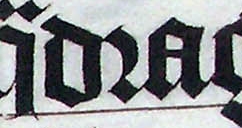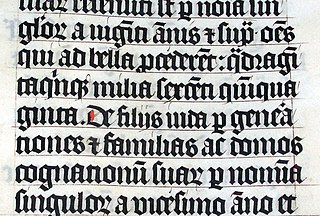
R, or r, is the eighteenth letter of the Latin alphabet, used in the modern English alphabet, the alphabets of other western European languages and others worldwide. Its name in English is ar, plural ars, or in Ireland or.
Koppa or qoppa is a letter that was used in early forms of the Greek alphabet, derived from Phoenician qoph (𐤒). It was originally used to denote the sound, but dropped out of use as an alphabetic character and replaced by Kappa (Κ). It has remained in use as a numeral symbol (90) in the system of Greek numerals, although with a modified shape. Koppa is the source of Latin Q, as well as the Cyrillic numeral sign of the same name (Koppa).
Ø is a letter used in the Danish, Norwegian, Faroese, and Southern Sámi languages. It is mostly used as a representation of mid front rounded vowels, such as (listen) and (listen), except for Southern Sámi where it is used as an diphthong.

The Romanian alphabet is a variant of the Latin alphabet used for writing the Romanian language. It is a modification of the classical Latin alphabet and consists of 31 letters, five of which have been modified from their Latin originals for the phonetic requirements of the language:
The bilabial clicks are a family of click consonants that sound like a smack of the lips. They are found as phonemes only in the small Tuu language family, in the ǂ’Amkoe language of Botswana, and in the extinct Damin ritual jargon of Australia. However, bilabial clicks are found paralinguistically for a kiss in various languages, including integrated into a greeting in the Hadza language of Tanzania, and as allophones of labial–velar stops in some West African languages, as of /mw/ in some of the languages neighboring Shona, such as Ndau and Tonga.

Letter case is the distinction between the letters that are in larger uppercase or capitals and smaller lowercase in the written representation of certain languages. The writing systems that distinguish between the upper- and lowercase have two parallel sets of letters: each in the majuscule set has a counterpart in the minuscule set. Some counterpart letters have the same shape, and differ only in size, but for others the shapes are different. The two case variants are alternative representations of the same letter: they have the same name and pronunciation and are treated identically when sorting in alphabetical order.

O is a letter of the Cyrillic script.

Hwair is the name of 𐍈, the Gothic letter expressing the or sound. Hwair is also the name of the Latin ligature ƕ used to transcribe Gothic.

The r rotunda ⟨ ꝛ ⟩, "rounded r", is a historical calligraphic variant of the minuscule (lowercase) letter Latin r used in full script-like typefaces, especially blackletters.

Scribal abbreviations or sigla are abbreviations used by ancient and medieval scribes writing in various languages, including Latin, Greek, Old English and Old Norse.

Izhitsa or Izhica is a letter of the early Cyrillic alphabet and several later alphabets, usually the last in the row. It originates from the Greek letter upsilon and was used in words and names derived from or via the Greek language, such as кѵрилъ or флаѵии. It represented the sounds or as normal letters и and в, respectively. The Glagolitic alphabet has a corresponding letter with the name izhitsa as well. Also, izhitsa in its standard form or, most often, in a tailed variant was part of a digraph оѵ/оу representing the sound. The digraph is known as Cyrillic "uk", and today's Cyrillic letter u originates from its simplified form.

Broad On is a positional and orthographical variant of the Cyrillic letter O (О о).

Uk is a digraph of the early Cyrillic alphabet, although commonly considered and used as a single letter. It is an accent nasal vowel from Slavonic language. To save space, it was often written as a vertical ligature (Ꙋ ꙋ), called "monograph Uk". In modern times, ⟨ѹ⟩ has been replaced by the simple ⟨у⟩.

In orthography and typography, a homoglyph is one of two or more graphemes, characters, or glyphs with shapes that appear identical or very similar but may have differing meaning. The designation is also applied to sequences of characters sharing these properties.
The internationalized domain name (IDN) homograph attack is a way a malicious party may deceive computer users about what remote system they are communicating with, by exploiting the fact that many different characters look alike. For example, a regular user of example.com may be lured to click a link where the Latin character "a" is replaced with the Cyrillic character "а".
Unicode has subscripted and superscripted versions of a number of characters including a full set of Arabic numerals. These characters allow any polynomial, chemical and certain other equations to be represented in plain text without using any form of markup like HTML or TeX.
Unicode has a certain amount of duplication of characters. These are pairs of single Unicode code points that are canonically equivalent. The reason for this are compatibility issues with legacy systems.

Multiocular O is a rare glyph variant of the Cyrillic letter O. This glyph variant can be found in a single 15th century manuscript, in the Old Church Slavonic phrase "серафими многоꙮ҄читїи҄". It was documented by Yefim Karsky from a copy of the Book of Psalms from around 1429, now found in the collection of the Trinity Lavra of St. Sergius.

Binocular O is one of the exotic glyph variants of Cyrillic letter O. This glyph variant can be found in certain manuscripts in the plural or dual forms of the root word eye, like Ꙫчи.

Double monocular O is one of the exotic glyph variants of the Cyrillic letter O. This glyph variant can be found in certain manuscripts in the plural or dual forms of the word eye, for example ꙭчи "[two] eyes". They were incorporated into Unicode as characters U+A66C and U+A66D in Unicode version 5.1 (2008).














